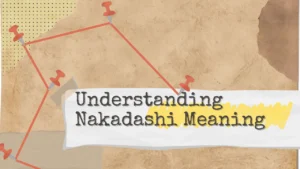Imagine stumbling across a term online that leaves you curious, confused, and maybe a bit embarrassed to ask about. That’s likely how you felt when you encountered “nakadashi.” Don’t worry—you’re not alone! This Japanese slang term pops up in anime, manga, and adult content, sparking questions about its meaning and cultural context. In this article, you’ll uncover what is nakadashi, its origins, and how it fits into Japanese pop culture. We’ll also explore related slang like kyokai, kosei, and JK, ensuring you leave with a clear, respectful understanding. Let’s dive in!
Understanding Nakadashi Meaning

The term nakadashi is a Japanese word often tied to adult content, but its meaning and usage are more nuanced than you might expect. To grasp it fully, let’s break it down step by step, exploring its literal translation, cultural implications, and role in modern media.
Literal Translation
Nakadashi comes from two Japanese words: naka (inside) and dashi (to release or let out). Combined, it refers to a specific act in adult contexts, often depicted in anime, manga, or adult films. While the term is explicit, its usage varies depending on the medium and audience.
Cultural Context
In Japan, nakadashi is primarily an adult term, but it’s not just a casual slang word tossed around in everyday conversation. It’s rooted in the country’s adult entertainment industry and reflects Japan’s complex relationship with sexuality and media. Understanding Japanese culture helps you see why such terms exist and how they’re perceived.
Usage in Media
You’ll often spot nakadashi in adult anime or manga, where it’s used to describe specific scenes. Its presence in anime culture or manga culture highlights how Japanese media blends explicit content with storytelling. However, it’s rarely used outside these contexts, making it a niche term.
Sensitivity and Awareness
When exploring terms like nakadashi, cultural sensitivity is key. Japan’s approach to adult content differs from Western norms, and using or discussing this term carelessly can offend. Always approach Japanese slang with respect for its cultural roots and intended audience.
Japanese Slang Explained
What is Japanese slang for? It’s a way to express ideas, emotions, or actions in a casual, often playful manner. Nakadashi is just one piece of Japan’s vibrant slang landscape. Let’s explore other slang terms like kyokai, kosei, and JK to see how they fit into Japanese pop culture.
Kyokai Meaning
What is kyokai in Japanese? Kyokai translates to “boundary” or “border” and is used in formal or technical contexts, like geography or organizations. In slang, it’s less common but might appear in niche subcultures to describe limits or divisions. It’s not as playful as nakadashi but shows the diversity of Japanese language.
Kosei in English
What is kosei in English? Kosei means “individuality” or “personality.” It’s a positive term often used to praise someone’s unique traits. In anime slang or manga terminology, you might hear it in character descriptions, celebrating a hero’s distinct qualities. It’s a great example of Japanese expressions that carry emotional weight.
JK Slang
What is a JK in Japanese slang? JK stands for joshi kosei, meaning “high school girl.” It’s a popular term in anime culture and Japanese subculture, often used to describe teenage female characters or real-life students. However, it can carry flirty or fetishized connotations in certain contexts, so use it carefully.
Slang in Context
Japanese slang like nakadashi, kyokai, kosei, and JK reflects the richness of Japanese colloquial language. Each term serves a purpose, whether it’s describing adult themes, individuality, or youthful energy. Understanding their context helps you navigate Japanese media without missteps.
| Japanese Slang Terms Comparison | Term | Meaning | Context | Usage Frequency |
| Nakadashi | Inside release | Adult media | Niche, explicit | |
| Kyokai | Boundary | Formal, niche slang | Rare in slang | |
| Kosei | Individuality | General, anime | Common, positive | |
| JK | High school girl | Anime, subculture | Very common |
This table compares key Japanese slang terms, showing their meanings and contexts. It’s a quick guide to help you understand how nakadashi fits alongside others.
Nakadashi in Anime and Manga
Anime and manga are global phenomena, and nakadashi often appears in their adult genres. Let’s explore how this term is used, its role in anime terminology, and why it matters to fans and creators.
Adult Anime Genres
Adult anime, or hentai, frequently uses nakadashi to describe specific scenes. These genres cater to mature audiences and are a distinct part of Japanese pop culture. The term’s explicit nature makes it a staple in this niche but less common in mainstream anime.
Manga Terminology
In manga slang, nakadashi appears in adult comics, often with detailed artwork and storytelling. Manga artists use it to convey intimacy or intensity, aligning with the medium’s expressive style. Fans of manga culture recognize it as a technical term within this art form.
Fan Communities
Anime and manga fans discuss nakadashi in online forums, often debating its depiction or cultural significance. These conversations highlight anime slang and Japanese subculture, showing how fans engage with niche terms. Respectful dialogue is crucial in these spaces.
Cultural Nuances
Using nakadashi in anime culture requires understanding language nuances. It’s not a term for casual chats at a convention! Its adult context means fans and creators handle it with care, ensuring it aligns with cultural sensitivity.
In my experience… Navigating anime slang like nakadashi can feel like learning a new language. Start with context—knowing where and why a term is used makes it easier to respect its place in Japanese media.
Cultural Sensitivity in Slang
Words like nakadashi carry weight, and using them without care can lead to misunderstandings. Let’s explore how to approach Japanese slang respectfully, especially in global contexts.
Respecting Boundaries
Japanese culture values context, and terms like nakadashi belong in specific settings. Using them outside adult media or without understanding their weight can offend. Always consider your audience and platform.
Global Misunderstandings
In Western contexts, nakadashi might be misunderstood as mere slang. But in Japan, it’s tied to adult content terms and carries cultural baggage. Learning these differences prevents awkward or harmful mistakes.
Learning from Mistakes
What I learned the hard way is… Misusing slang like nakadashi can alienate people. Once, I heard someone toss it into a casual anime discussion, and the room went silent. Study the term’s place before using it.
Educational Approach
Approach Japanese slang guide materials with curiosity and humility. Resources like language blogs or cultural forums can clarify terms like nakadashi, kyokai, or JK, ensuring you use them wisely.
| Cultural Sensitivity Checklist | Action | Purpose | Example |
| Research context | Avoid misuse | Check nakadashi usage in anime slang | |
| Ask experts | Ensure accuracy | Consult a Japanese language teacher | |
| Use respectfully | Prevent offense | Avoid nakadashi in casual chats |
Actionable Tips for Learning Slang
Mastering Japanese slang like nakadashi takes practice and care. Here are five actionable strategies to help you understand and use these terms confidently.
- Research Context First: Before using nakadashi or JK slang, study their origins. Use trusted sources like language blogs or anime forums to grasp their meaning and usage.
- Watch Authentic Media: Dive into Japanese media like anime or manga to see how terms like kosei or kyokai are used. Subtitled content helps you catch nuances.
- Join Fan Communities: Engage with anime culture forums on Reddit or Discord. Ask questions about manga slang to learn from experienced fans.
- Practice Cultural Sensitivity: Always consider cultural context when discussing nakadashi. Avoid using it in inappropriate settings to respect Japanese subculture.
- Use Language Apps: Apps like Duolingo or Jisho.org can clarify Japanese expressions. Look up kosei in English or kyokai meaning for accurate translations.
Here’s a tip I always give beginners… Start small with Japanese slang. Learn one term at a time, like JK or kosei, and practice using it in context before tackling niche words like nakadashi.
Related Japanese Slang Trends
Language trends in Japan evolve fast, especially in pop culture Japan. Let’s look at how nakadashi and related terms fit into broader slang patterns, keeping you in the loop.
Slang in Social Media
On platforms like X or TikTok, JK slang and anime terminology thrive. While nakadashi is less common due to its adult nature, related terms like kosei pop up in motivational posts, reflecting Japanese colloquial trends.
Anime and Manga Influence
Anime slang drives slang evolution. Terms like JK or nakadashi gain traction through fan translations and memes, shaping manga culture. Fans create glossaries to track these Japanese expressions.
Global Spread
Japanese pop culture spreads slang worldwide. Kosei in English or JK in Japanese slang appears in global fan content, but nakadashi remains niche due to its explicitness, highlighting language nuances.
Learning Resources
To stay updated, explore Japanese slang guide books or websites like Tofugu. They cover terms like kyokai in Japanese or adult anime terms, helping you navigate cultural slang.
| Popular Japanese Slang Trends | Term | Platform | Popularity | Context |
| JK | TikTok, X | High | Anime culture | |
| Kosei | Moderate | Inspirational posts | ||
| Nakadashi | Forums | Low | Adult content terms |
FAQs About Nakadashi and Japanese Slang
What does nakadashi mean in anime?
Nakadashi refers to an explicit act in adult anime or manga, often depicted in hentai. It’s a niche term used in specific genres, not mainstream anime.
Is nakadashi used in everyday Japanese?
No, nakadashi is not casual slang. It’s tied to adult content terms and rarely used outside adult media due to its explicit nature.
What is JK in Japanese slang?
JK means joshi kosei or “high school girl.” It’s common in anime slang and Japanese subculture, often describing teenage female characters.
What is kosei in English?
Kosei translates to “individuality” or “personality.” It’s a positive term in Japanese expressions, used in anime or daily life to praise uniqueness.
How can I learn Japanese slang safely?
Start with trusted resources like Tofugu or anime forums. Focus on context, avoid adult anime terms like nakadashi in casual settings, and practice cultural sensitivity.
Why is cultural context important for nakadashi?
Nakadashi is tied to Japanese culture and adult media. Misusing it can offend or confuse, so understanding language nuances ensures respectful use.
Read More: Understanding CNLawBlog: A Comprehensive Legal Resource
Conclusion
Exploring what is nakadashi opens a window into Japanese slang and pop culture Japan. From its explicit roots in anime culture to its place alongside terms like kyokai, kosei, and JK, this term reflects the complexity of Japanese language. By understanding its context, respecting cultural sensitivity, and using resources wisely, you can navigate manga slang and beyond with confidence. Whether you’re a fan of Japanese media or just curious, these insights equip you to engage thoughtfully with anime terminology and Japanese subculture. Keep learning, stay respectful, and enjoy the journey into Japan’s vibrant linguistic world!

Sarah Wilson is a skilled writer who works in many different areas. She creates interesting and helpful content, sharing useful information and keeping readers engaged with her knowledge and love for a wide range of topics.




